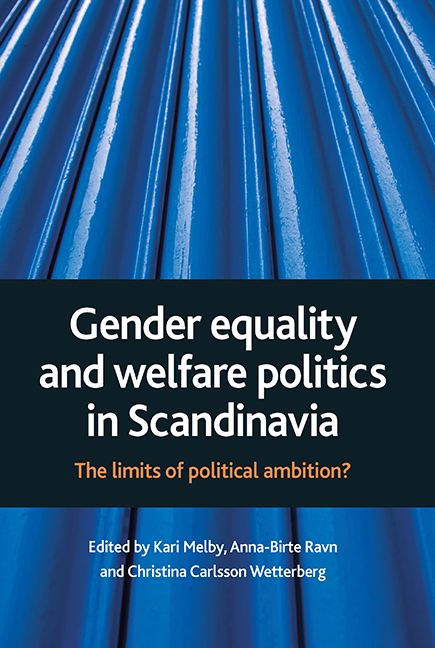Book contents
- Frontmatter
- Contents
- List of tables
- Preface
- Notes on contributors
- A Nordic model of gender equality? Introduction
- Part One Meanings of gender equality in Scandinavian welfare policy
- Part Two Current challenges: competing discourses on gender equality
- Postscript Gender, citizenship and social justice in the Nordic welfare states: a view from the outside
- Postscript Future research on gender equality in the Scandinavian countries
- Appendix Tables 1-10
- Index
one - Woman-friendly policy paradoxes? Childcare policies and gender equality visions in Scandinavia
Published online by Cambridge University Press: 21 January 2022
- Frontmatter
- Contents
- List of tables
- Preface
- Notes on contributors
- A Nordic model of gender equality? Introduction
- Part One Meanings of gender equality in Scandinavian welfare policy
- Part Two Current challenges: competing discourses on gender equality
- Postscript Gender, citizenship and social justice in the Nordic welfare states: a view from the outside
- Postscript Future research on gender equality in the Scandinavian countries
- Appendix Tables 1-10
- Index
Summary
Introduction
Since the late 1980s, feminist scholarship has reconceptualised the equality–difference dilemma, which has plagued feminist activists and policy makers for many decades. They have been confronted with the claim that they should choose either difference or equality as the route to achieving gender equality, because the two should be regarded as logically incompatible. The dilemma has been closely interconnected with the gendered division of breadwinning and unpaid care work and the public–private split, which has been attached to it.
The rethinking of the dilemma has generated a broad consensus that it is neither universal nor static, and that it varies in significance and appearance according to time and place. Furthermore, most scholars agree that the dilemma rests on a socially constructed dichotomy. This calls for contextualised studies of how the dilemma is constructed in time and space.
In this chapter I focus on the political construction of the equality–difference dilemma in so-called woman-friendly Scandinavian welfare policies. I address different policy logics of childcare policies in Sweden, Norway and Denmark and the visions of gender equality underpinning them. I commence with the rethinking of the dilemma in feminist scholarship during the past decades. Subsequently, I discuss whether the notion of one coherent Scandinavian welfare model should be challenged, and I critically address the term ‘woman friendliness’ and discuss its conceptual strength. The following sections explore the underlying visions of gender equality of day-care policies, parental leave and homecare cash benefits, and I focus on the varying timing and context of these policies in the three countries. Finally, I offer some perspectives on the political construction of the equality–difference dilemma in the Scandinavian countries, and how woman-friendly policies are presented in a European context.
Equality versus difference – a contextual and socially constructed dilemma
For centuries, feminists have grappled with the equality–difference dilemma both as activists and as scholars. Political scientist Carole Pateman named this dilemma after Mary Wollstonecraft, a feminist pioneer who struggled with the problem both personally and in her activism for female suffrage in Britain.
- Type
- Chapter
- Information
- Gender Equality and Welfare Politics in ScandinaviaThe Limits of Political Ambition?, pp. 27 - 42Publisher: Bristol University PressPrint publication year: 2008
- 6
- Cited by



